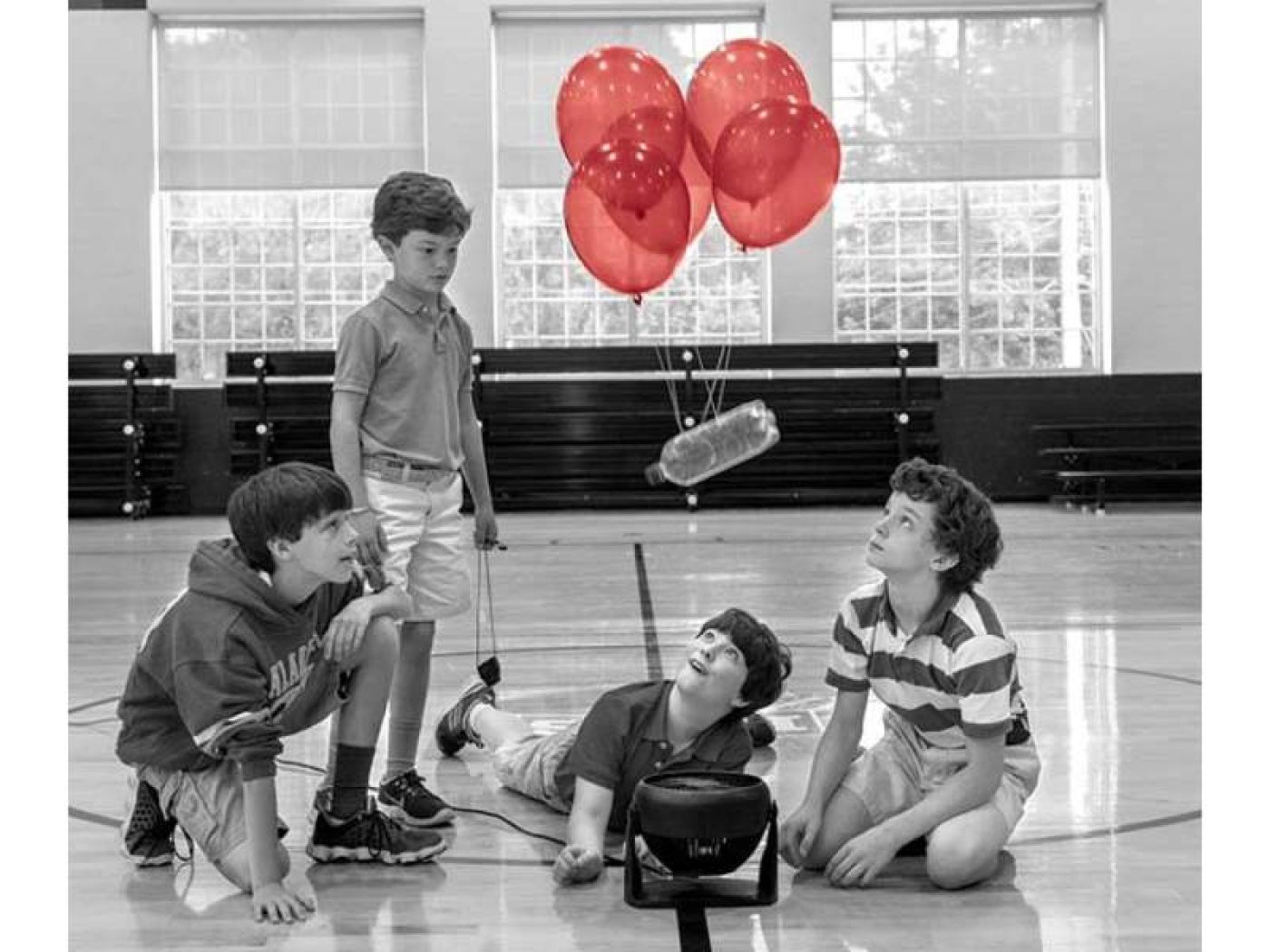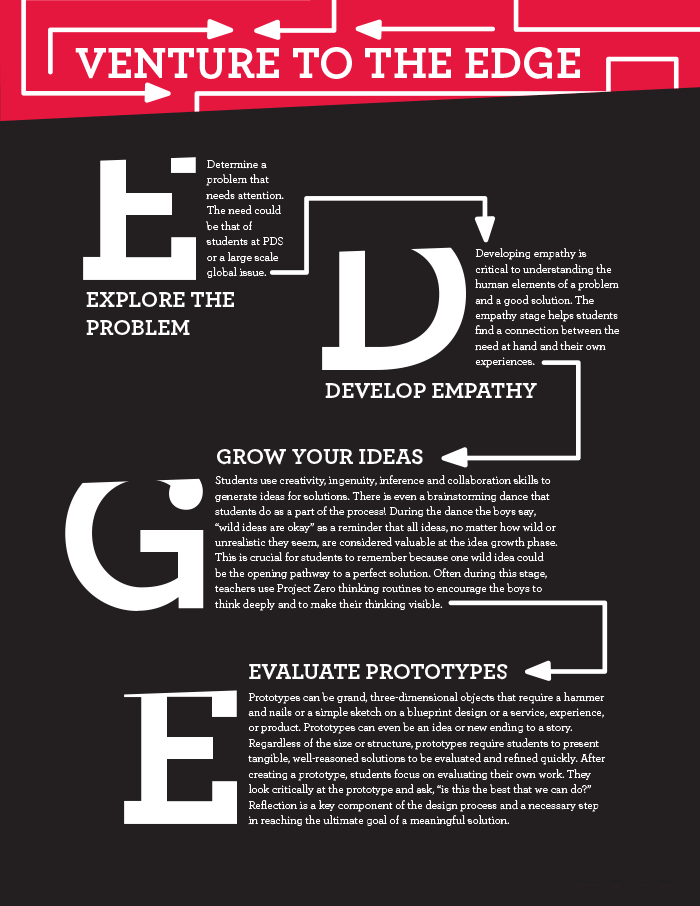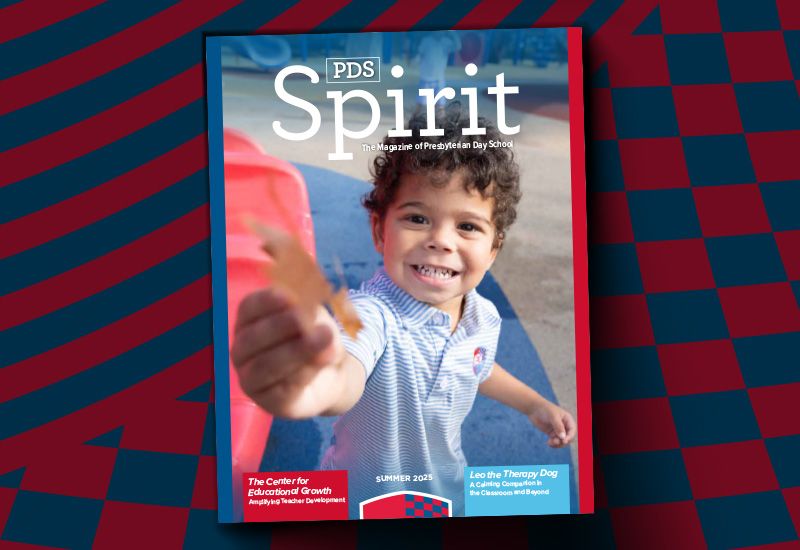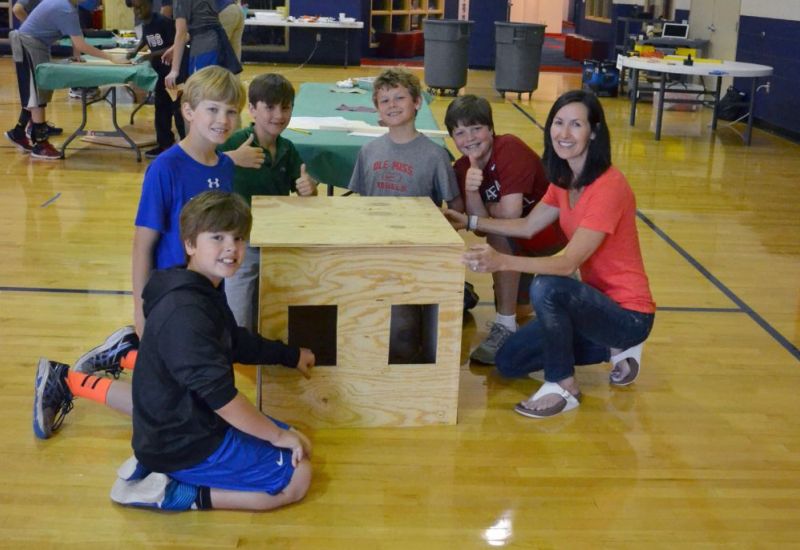
EDGE Design Thinking
In her 5th-grade science class, Kim Bullard began a recent project by introducing herself as a client—not the teacher—seeking a solution from a company—her students. Faced with the task of developing an experiment to effectively model Newton’s Second Law, students began to explore ways to demonstrate how the acceleration of an object is dependent upon both the net force applied and the mass.
After brainstorming solutions, Bullard’s students raced around the classroom for supplies to build prototypes. With only a small amount of guidance and a checklist, the students successfully designed experiments and created videos promoting their solutions. “At no point were students focused on learning just for a grade. They were working hard to understand why we should believe Newton. They truly wanted to understand and know. The boys collaborated with peers to design experiments. They had an opportunity to present their company’s product to the class and to give feedback to their peers.”
How can we ensure our students have tools to be successful in a job or field that is yet to be created?
This project is based on a critical-thinking and problem-solving approach called Design Thinking that is rapidly becoming a major component of the learning at PDS. Design Thinking is a systematized thinking process focused on generating usable solutions to real problems, issues or dilemmas. This thinking process can be applied to the creation of products, services, experiences, or systems that solve a problem in a manner that fits the end-user’s needs. The process requires asking questions, researching, synthesizing information, prototyping, reflecting, and collaboration. Design Thinking was popularized by engineers and educators at Stanford University who recognized its usefulness in making learning engaging, rigorous, and relevant for students.

With the business world continuously changing, schools are challenged with how to prepare students for the unknown. How can we ensure our students have tools to be successful in a job or field that is yet to be created? What type of learning must we provide for students to flourish in the unknown? Presbyterian Day School, like other innovative schools in the country, believes Design Thinking is an indispensable tool students need to be the motivated and capable contributors the world needs. Having examined the design thinking movement at the d.school at Stanford and at the company IDEO, as well as training at the Henry Ford School, PDS has customized the concepts of design thinking for our school and developed a framework to help boys remember the steps to the Design Thinking process. We call our framework EDGE: Explore the problem; Develop empathy; Grow your ideas; Evaluate prototypes. “The EDGE Design Thinking process coordinates with the Harvard Thinking Routines and culture of thinking that we have worked so hard to create in our learning environment over the last few years,” explains Susan Droke, Assistant Head of School for Teaching and Learning. “Like a thinking routine, which is a systemized way to approach thinking about a problem, like a gap analysis or cost-benefit analysis, the EDGE Design Thinking process helps each student work through the steps to develop their solution.”
This year, Alice Parker, one of the school’s Learning Specialists, is working with teachers to implement EDGE Design Thinking at PDS. “Our boys are learning to apply the knowledge and skills developed in the classroom to real-word problems in need of creative solutions,” says Parker. The EDGE Design Thinking process is powered by the boys’ innate curiosity and creativity. Learning comes alive with meaning and purpose, and the results are exciting: our students craft designs that are innovative, unique solutions that can only be conceived of by gaining a deep understanding of the project. “With EDGE Design Thinking, the boys own the learning process from start to finish,” says Parker.
EDGE Design Thinking lends itself well to the classroom, because it encompasses many of the teaching techniques that master teachers use. Students must develop the skills of asking good questions, collaborating with peers to design effective solutions, prototyping recommended solutions, and taking time to reflect on and refine their recommended solution or prototype based on the feedback they are gathering. These skills can only be taught when the learning is shifted from the teacher to the student. EDGE Design Thinking makes this shift possible by establishing a framework that allows students the autonomy to work through the thinking steps with teachers there as resources and guides. For teachers who are used to having control of each step in the learning journey, ceding control to the students in this process isn’t easy. “As teachers, we have to understand that our students won’t always get the process right the first time. They won’t necessarily generate deep, quality ideas right at first, and this is okay,” says Mrs. Bullard.
“Teachers like linear tasks and clarity. The process of thinking toward a solution as outlined in the EDGE Design Thinking process is not linear and it can be very intimidating. When we talk about giving the boys ownership of the learning process, this is what it’s all about. Students need to feel that the learning outcome is in their hands; otherwise there is no real student engagement.”
The EDGE Design Thinking process is rapidly expanding across grade-levels and subject areas at PDS. On the first day of school, Ms. Trefz’s 5th-graders used the process to customize the layout and function of their classroom. Students contributed ideas for improving the flow of the learning space, drawing blueprints to illustrate solutions. During the brainstorming portion of the process, one student presented the idea of a “man cave” in the classroom, a space for the students to relax from the worrisome troubles of 5th grade. While the idea might seem wild and unrealistic for a typical classroom, the students embraced the idea and were determined to fit the space into the classroom. Today, the Crusader Cave is a frequently visited corner of the classroom.
The second-grade science curriculum is based on the question, “How are all living things connected?” The boys in Stephanie Taylor’s 2nd-grade class are researching oil spills and their effect on people and animals. They will interview a variety of experts in this area as well as one Gulf Coast family in order to develop empathy for those affected by oil spills. The boys will then design solutions to deal with an oil spill crisis in Zoolandia, a zoo-based game Ms. Taylor and Mrs. Diaz modeled after John Hunter’s World Peace Game. John Hunter, teacher from Charlottesville, Virginia, was named the Martin Institute’s first Teaching Excellence Fellow in 2011.
Students in Sherry Creasman’s 3rd-grade class will work on improving utilization of the crosswalk during afternoon carpool from the perspective of the students. They will analyze the flow of traffic along with the needs of parents and students during this time.
In Jean Naber’s class, 6th-graders will examine all aspects of famous escape plans throughout history while studying Operation el Duce, the World War II mission responsible for freeing Mussolini from captivity. After interviewing several people who have had hands-on experience with military escape plans, they will then design an alternate exit strategy for Operation el Duce.
“Students need to feel that the learning outcome is in their hands; otherwise there is no real student engagement.” Kim Bullard, Science Lab Instructor
In response to the strategic implementation of Design Thinking thinking in the classrooms, PDS has just opened a new dedicated art and design space (see page 18). This new space was created by combining three classrooms together to make one large, flexible space. The space is intentionally designed to foster collaboration, creativity, and the ability for students to build and express their ideas and conceptual thinking in physical form, be it an artistic rendering or a prototype constructed from whatever materials are at hand. In support of the EDGE Design Thinking process students and teachers are using, the new space has been named the Dobbs EDGE Studio.
The Dobbs EDGE Studio will flex and adapt to meet the needs of the learner and the learning. Large glass windows will allow others to see the work going on which communicates the message of how deeply important the process is in addition to the outcome of the learning. PDS’ art studio will be housed in this space, and there will also be breakout rooms for small group work as well as tools and materials for designing and tinkering. The intention is for the space in the Dobbs EDGE Studio to be inspiring and motivating to students and their teachers. In essence, the space itself becomes a teacher, as it opens up the possibility of discovery and investigation, experimentation and expression, deep wondering and collaboration. The space itself invites the student to develop his ingenuity and leverage all the learning he can muster to contribute, create, and communicate.
“With EDGE, the boys own the learning process from start to finish.” Alice Parker, Learning Specialist
In just a short period of time, PDS boys and faculty members know what taking a problem or situation “to the EDGE” means—to use a systematized and rigorous thinking process to develop solutions that are only possible when students use empathy, creativity, collaboration and critical thinking. Though the boys in Mrs. Bullard’s science class may not know it, PDS continues to push teaching and learning to new places so that PDS boys are prepared for the world and its challenges. “PDS is taking learning to the edge,” Mrs. Bullard explains, “making learning purposeful and fun.”
This email address is being protected from spambots. You need JavaScript enabled to view it.
Available year-round!
We love showing off our campus and our boys.
To Schedule a tour, contact Rachel Bishop, Director of Admission at











